Water
Authentic Solutions
WATER RENEWAL
Water Solutions
For The Navajo Nation
Important To Note:
In general, only two forms of water are recognized by mainstream science as being commonplace, namely seawater and groundwater – with the latter being produced by runoff from rain and snow (precipitation).
It is well known that there are also relatively static subterranean water deposits known as aquifers. Aquifer water, however, is in many cases not of drinking water quality and such water is thus primarily suitable for irrigation.
In addition to the above, leading Hydro-Geologists in the past century have recognized that there are two more types of New Water which are distinct from seawater and groundwater, which with today’s technology may be found within the Earth’s crust and tapped with relative ease to provide new sources of water, that were previously never thought to have existed
These two types of New Water – which are NOT Aquifer Water – are:
1. PRIMARY WATER
2. VEIN WATER

Flowing River Solutions is a new enterprise, which exists to find & provide a broad range of proven & potential Authentic Solutions that may be used by communities, groups, organizations & individuals all around the world, in order to improve their own lives and the lives of others to help create:
A Better World For All.
The first community with whom we are hoping to work is The Navajo Nation.
Introducing Primary Water
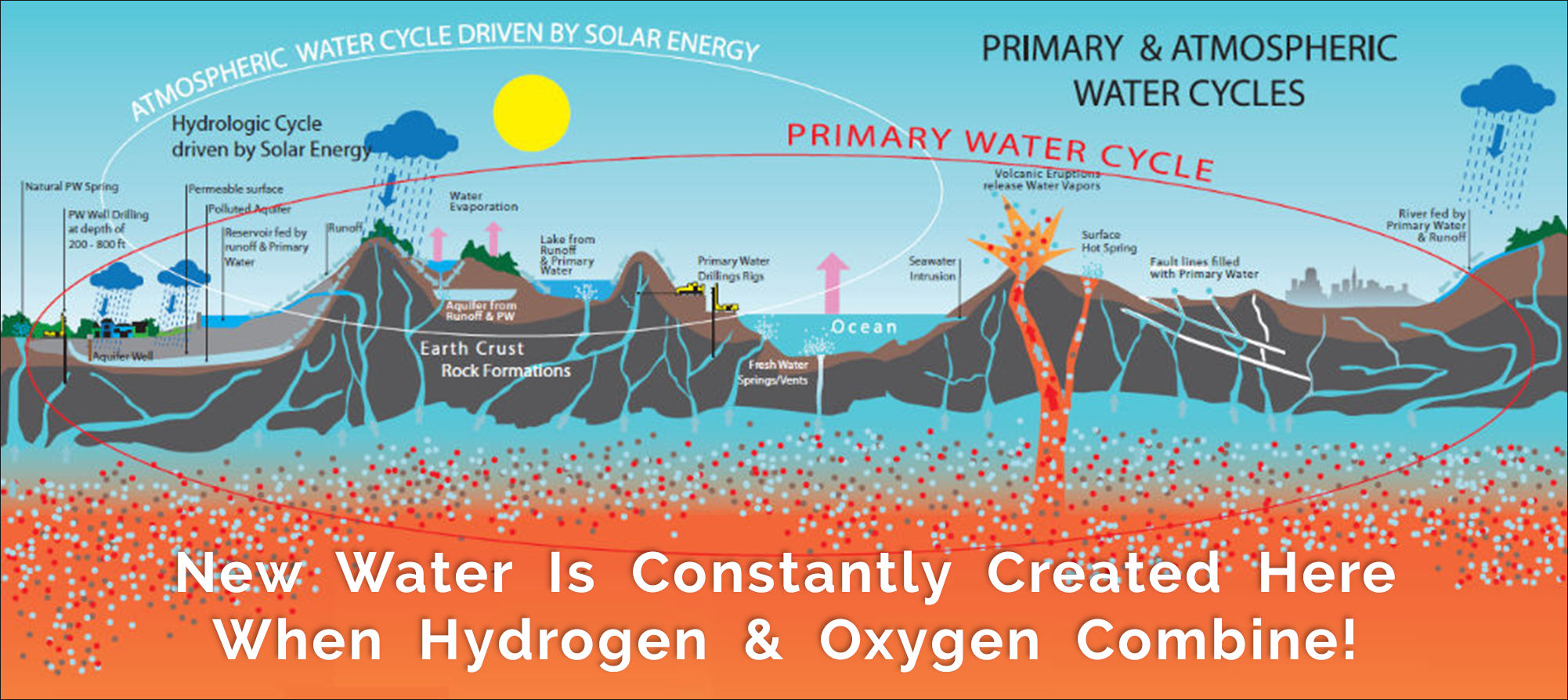
Please Note ~ As the above graphic illustrates, neither Primary Water nor Vein Water are aquifer water. Aquifers are generally created by groundwater drainage, however, Primary Water and Vein Water may also ‘leak’ into aquifers, which helps to sustain those aquifers. Image Credit: The Primary Water Institute – http://www.primarywaterinstitute.org/

Proven Authentic Solution – Primary Water:
There Are, It Is Claimed, Two Distinct Forms Of
Earth-Generated Water, Namely:
Primary Water & Vein Water
The Theory Of Primary Water
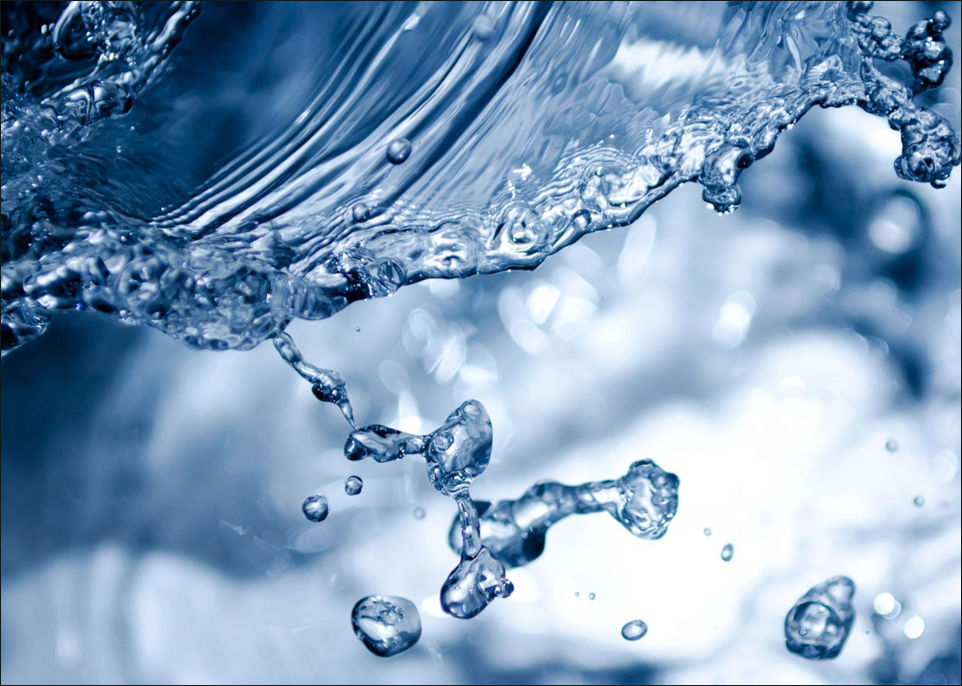
New Water is the Sustainable Source of all Fresh Water on Earth

New Water, in the form of Primary Water, is not the same thing as recycled Ground Water.
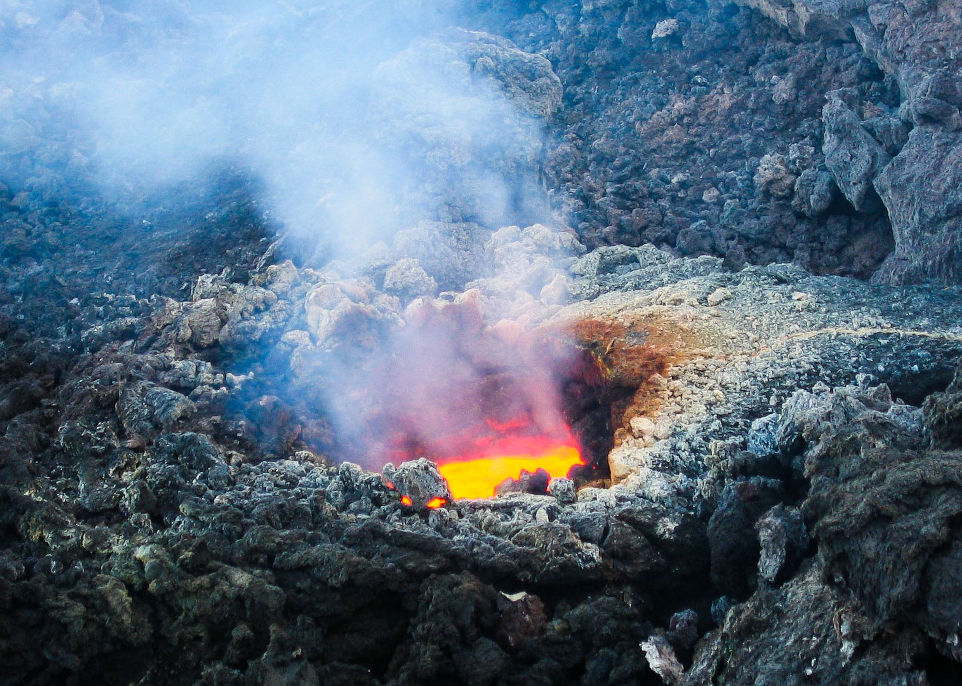
Primary Water is produced deep in the earth when Oxygen & Hydrogen join together through geological processes.
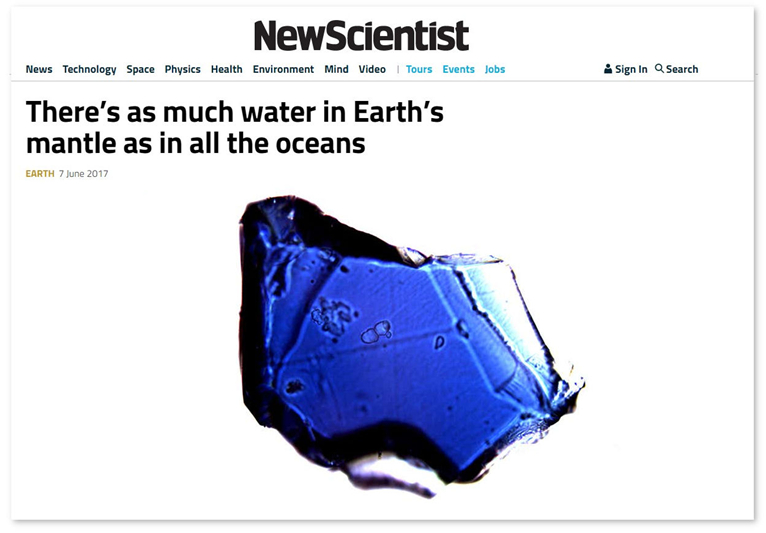
Recent research shows a vast ocean of such New Water exists throughout the Earth’s mantle.

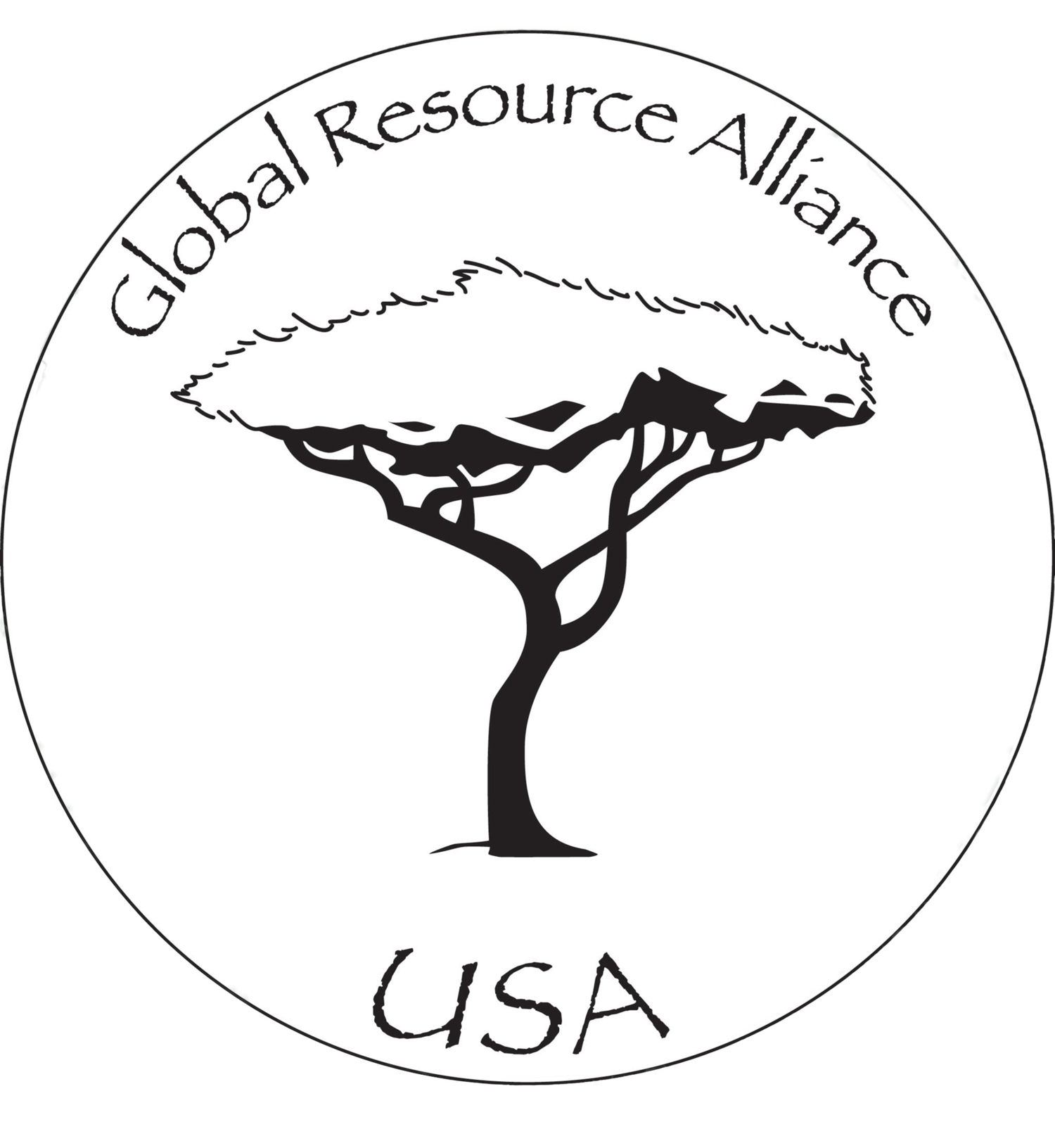 The above video shows a successful drilling operation in Tanzania, Africa, carried out by Global Resource Alliance (GRA), with the support of the late Pal Pauer.
The above video shows a successful drilling operation in Tanzania, Africa, carried out by Global Resource Alliance (GRA), with the support of the late Pal Pauer.
Global Resource Alliance has agreed to work with Flowing River Solutions.
Link to GRA website: https://gra-usa.org/
Primary Water
Proven New Water Solution:
Because of the global urgency to find new sources of fresh potable water, Flowing River Solutions is primarily focusing its efforts on finding and facilitating access to abundant amounts of New Water, almost anywhere on Earth ~ thus helping to:
- Revitalise Human Communities
- Repair Ecosystems and
- Mitigate Drought ~ by:
Replenishing Water

The Primary Water & Vein Water Story

The New Water Story Begins
Over 100 Years Ago
Dr Eduard Suess
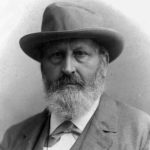 In addition to being well known for his theory of Gondwanaland, the Austrian geology professor Dr Eduard Suess of Vienna might be considered the founder of modern Geo-Hydrology & Hydro-Geology as a result of the selection of his proposal to solve the water quality problems of Vienna in the 1850s when the city suffered a high incidence of typhoid.
In addition to being well known for his theory of Gondwanaland, the Austrian geology professor Dr Eduard Suess of Vienna might be considered the founder of modern Geo-Hydrology & Hydro-Geology as a result of the selection of his proposal to solve the water quality problems of Vienna in the 1850s when the city suffered a high incidence of typhoid.
Dr Suess’ proposal, chosen from among many, was to develop spring water wells high above the city and use gravity flow to the population. It was during this time, and after his study of the Carlsbad (now Karlovy Vary) thermal springs, that he formulated the concepts of Juvenile Water (aka Primary Water) and its occurrence often in the mountains and at higher elevations, rising under great pressure related to volcanism.
Suess’ 1862 work, “The Ground Of The City Of Vienna”, described the relation of the great city to the Alps, and the hydrology of the urban water supply and drainage. The book went on to discuss the relation of wells, groundwater, and water quality to health and epidemics. His work is considered the “historical foundation of the geoscience branch of urban geology.” It resulted in the construction of the development of a new 70-mile water-supply system from the Alps to Vienna in 1873.
Adolf Erik Nordenskiöld:
 The term “Primary Water” dates to a scientific paper in the Geological Society of Stockholm Proceedings of 1896 by renowned Finnish-Swedish geologist, mineralogist and explorer Adolf Erik Nordenskiöld titled, “About Drilling for Water in Primary Rock” for which he was nominated for the first Nobel Prize in Physics.
The term “Primary Water” dates to a scientific paper in the Geological Society of Stockholm Proceedings of 1896 by renowned Finnish-Swedish geologist, mineralogist and explorer Adolf Erik Nordenskiöld titled, “About Drilling for Water in Primary Rock” for which he was nominated for the first Nobel Prize in Physics.
Nordenskiöld, who was very familiar with the pioneering work of Dr Suess, died in August 1901 before the first prizes were awarded, however it was Nordenskiöld’s scientific paper about drilling for water in primary rock that was translated into English and included in what is considered to be the Primary Water textbook, “New Water for a Thirsty World” by University of Southern California professor Dr. Michael Salzman published in 1960, with a forward by Aldous Huxley, and which largely traces the career of the German-educated mining engineer and pioneer primary water geo-hydrologist Stephan Riess.
Such leading scientists as Nobel Prize winners Linus Pauling and Willard Libby as well as the eminent geologist Ralph Arnold collaborated with Salzman during the four years he spent researching the subject as a result of numerous news articles chronicling Riess’s exploits during the 1950s.
Stephan Riess:
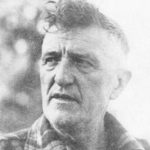 It was Stephan Riess who introduced the term primary water into English and the scientific lexicon by calling: “the new water he finds ‘primary’ water because of its close association with primary minerals.“
It was Stephan Riess who introduced the term primary water into English and the scientific lexicon by calling: “the new water he finds ‘primary’ water because of its close association with primary minerals.“
In 1957, Encyclopedia Britannica’s Book of the Year wrote the following on The “New Water” Theory of Stephan Riess:
“Stephan Riess of California formulated a theory that “new water” which never existed before, is constantly being formed within the earth by the combination of elemental hydrogen and oxygen and that this water finds its way to the surface, and can be located and tapped, to constitute a steady and unfailing new supply.”
— 1957 Brittanica Book of the Year
The non-profit Primary Water Institute was founded in 2014 by longtime Riess protégé, the equally pioneering Hydro-Geologist Pal Pauer, in order to educate and train the next generation of Primary Water specialists.
Pal Pauer:
 Pal Pauer emigrated from Hungary to the US in 1956 at the age of 15 to escape from Soviet occupation. He attended Ojai, CA high school where he met Stephan Riess, who was lecturing on the science of Primary Water.
Pal Pauer emigrated from Hungary to the US in 1956 at the age of 15 to escape from Soviet occupation. He attended Ojai, CA high school where he met Stephan Riess, who was lecturing on the science of Primary Water.
After graduating he went on to College in UC Santa Barbara to take courses in Geology while doing an apprenticeship with Stephan Riess who became his mentor/teacher/well drilling partner until Riess’ death in 1985. Besides working as a Hydro-Geologist, Pal Pauer also became a master mason, successful builder and real estate investor throughout California.
Below is a List of Pal Pauer’s major Primary Water drilling projects showing date, location, depth & structure, gallons per minute water output:
- 1961 Riess Property, Sulphur Mountain, Ventura Cty: 1 well; 400’, Monterey Shale, 50 gpm
- 1962, California City, Mohave Desert: 4 wells, 700′ to 1400′ bedrock, av. 700 gpm
- 1962 Sulphur Mountain, 2 additional in Ventura Cty; both at 350′, Monterey shale; 50 & 25 gpm
- 1965 Cuyama Valley, Kern Cty, CA, 500′, meta sedimentary,150gpm (redrilled 1972 after earthquake, San Fernando 1971; 5 miles from San Andreas fault)
- 1966 Three Rivers, Tulare Cty.; 200′, plutonic granite, 200 gpm
- 1970-1975 Santa Ana Canyon, Ventura Cty; 5 wells: largest 150 feet/700 gpm, sespe sandstone & coldwater, horizontal to 17 feet, 10 gpm; 110’/50 gpm; 200’/30 gpm; 200’/50 gpm
- 1975-1978 & 1984-1987 Coyote Canyon, Ventura Cty. west of Lake Casitas, 2 wells & artisan well: sespe sandstone & coldwater structure: 150’/800 gpm; 200’/75
- 1978 Sulphur Mountain, Ojai, Ventura Cty, 400′, Monterey shale, 75 gpm
- 1978-83 Pacific City, Tilamook Cty, OR, elected to District Sewer & Water District, 3 wells: Cape Kiwanda for sewer diet: each 120’ kiwanda alluvium structure/ 1200 gpm!!
- 1980 Cloverdale, Tilamook Cty, OR, 175’ meta sedimentary, 50 gpm
- 1987 Siskiyou Cty, CA, Klamath River Northern Ranch, 400 acres, 175’ in unsorted volcanics, 200 gpm
- 1995 Yreka, California, Hawkinsville/Humbug District, Siskiyou Cty, Pauer property, volcanics, 200’ /400 gpm;
- 2nd well: 150’deep/75gpm
- 3rd well: 150’deep/50gpm
- 4th well: 200’deep/25gpm
- 5th (1965) 250’deep/50 gpm
- 6th 250’deep/20gpm
- 7th 250’deep/25gpm
From 1995 on until to date, Pal Pauer has supervised and is involved in Primary Water drilling projects in:
- Tanzania
- Kenya
- Morocco
- Hungary
- Mexico
- Philipines
- Marshal Islands
- U.S.A.
Pal states on the website of his Primary Water Institute:
“We hear that the wars of the 21st century will be fought over water – rather than oil as in the last. Nothing holds more potential to abolish these wars – and ameliorate the shocking condition of nearly one billion people on earth without access to clean, safe water — than the science of Primary Water.” Pal Pauer
Lyn Hebenstreit
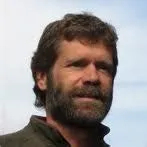 In the past few decades Pal Pauer has worked closely on many of the above projects with Lyn Hebenstreit (pictured left), the President of Global Resource Alliance, Inc., which is a tax-exempt US non-profit organization founded in 2001 to promote simple, natural and sustainable solutions to the challenges of hunger, poverty and disease in developing regions of the world.
In the past few decades Pal Pauer has worked closely on many of the above projects with Lyn Hebenstreit (pictured left), the President of Global Resource Alliance, Inc., which is a tax-exempt US non-profit organization founded in 2001 to promote simple, natural and sustainable solutions to the challenges of hunger, poverty and disease in developing regions of the world.
As Lyn states in one of his articles:
“Contrary to popular belief, clean, safe, fresh water on our planet is not scarce, but abundant. That’s how I began a presentation at a conference earlier this year on “New Generation Watershed Management in Africa” co-sponsored by the United Nations Food and Agriculture Organization (FAO) and the Freedom from Hunger Council of Ireland (Gorta).
First of all, let me clarify what I mean by abundant. Abundance is not unlimited supply or vast surpluses, but simply, always enough – when used consciously, responsibly and conservatively. Do we really need more than that?”
Lyn’s work in a number of African countries with Global Resource Alliance includes not only drilling numerous successful Primary Water boreholes with the assistance of Pal Pauer, but going beyond that and training numerous local teams in every aspect of the work involved in finding and accessing Primary Water, including drilling-skills.
The Theory Of Vein Water
Hans Anton Rieder:
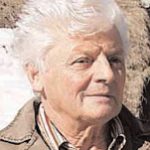 Hans Anton Rieder is a world-famous Swiss water-finder, who views the current water-situation, worldwide as follows:
Hans Anton Rieder is a world-famous Swiss water-finder, who views the current water-situation, worldwide as follows:
“The world is not in crisis about water resources, but more in a crisis about the understanding of the origin and the dynamics of the global water system and the energies intrinsically tied to water.”
His theory states that there is a whole network of veins of Earth-generated water running beneath the surface of the Earth.
Accordingly, he refers to the type of New Water which flows throughout this distinct water-system within the planet as:
- Vein Water
Rieder’s theory implies that Vein Water is different to Primary Water, even though both are created by the Earth, within the Earth. He further states that there seems to be a considerably larger water resource in this Vein Water System than exists in the surface water in rivers and lakes as well as in all of the fresh water known to us.
Hans Anton Rieder claims to be able to locate these water veins at every place in the world in the vicinity of 200 meters: in deserts, on mountain tops and on the smallest of islands.
In other words, apart from the surface-water cycle, which is already well understood by mainstream science, there seems to be an unlimited supply of fresh water in the earth, according to Hans Anton Rieder.
His theory appears to be supported to some degree, since Rieder has drilled over 300 wells around the world in the past 30 years, successfully finding water in places where mainstream geologists / scientists declared that there was simply no water to be found.
It is claimed that in almost 100% of the drilled holes, there is fresh water flowing under pressure.
The following are brief details of some of the anecdotal claims made in relation to Hans Anton Rieder’s drilling projects:
“When he was looking for water in Eritrea for a Swiss charity helping the desperately needy population, and he let the drilling begin in the place he designated, one of the geologists, who was hired by the Swiss TV team there, said: “There is definitely no water here. This is a very unfavourable place. Drilling a hole here is a waste of time and money. If he finds water here, I will change my profession.”
When the boring was successful and the drinking water came bubbling up, the geologist couldn’t believe it. (But as far as we know, he hasn’t changed his profession!)
He also proved his theory when he started drilling for fresh water on a tiny Pacific island. The island was too small to have any ground water. Against all scientific reason, he found drinkable water there as well – to the delight of the fishermen. Now they no longer have to transport water onto the island.
Up to now, his greatest achievement was for the “untouchables” in the Thar Desert (Rajasthan, India): thanks to 9 successfully drilled holes, 40,000 people from 35 villages are now provided with sufficient drinking water. He has realised what was written 2,500 years ago in the Vedas: ‘One day, when everything seems hopeless, the blood of the earth – the water veins hidden in stone – will save mankind.’”
Norbert Cibis:
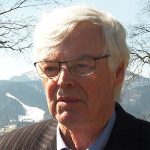 Independent scientific researcher Norbert Cibis was inspired by the research and work of Stephan Reiss, Pal Pauer and Hans Anton Rieder, each of whom have employed dowsing as part of their approach to locating Primary Water (Reiss & Pauer) and Vein Water (Rieder).
Independent scientific researcher Norbert Cibis was inspired by the research and work of Stephan Reiss, Pal Pauer and Hans Anton Rieder, each of whom have employed dowsing as part of their approach to locating Primary Water (Reiss & Pauer) and Vein Water (Rieder).
He has invested more than twenty years of his life into researching alternative ways of locating water, to provide a more technical approach that may be used to support dowsing, or even instead of dowsing.
As a result of his own pioneering research, Norbert claims to have developed an extremely accurate proprietary method of remotely calculating and pinpointing the following:
- The likely ~ almost certain ~ precise location of all types of underground water sources.
- The depth of all types of underground water sources.
- The specific type of underground water sources – including Aquifer Water, Primary Water and Vein Water.
- The qualities and likely potability of underground water sources.
It is important to note that the above can all be done by Norbert from his base in Germany, or indeed anywhere else, before any on-site pre-drilling or drilling work is carried out. As Pal Pauer noted in a recent conference call with Norbert and Flowing River Solutions team members, if the claims being made by Norbert can be confirmed, this will make it much, much easier to find the best quality new water sources with minimal or zero test drilling.
In addition to the above, once a potential drilling location for Primary Water or New Water has been pinpointed by Norbert Cibis’ approach, he is able to use his on-site monitoring and measuring methodology to support the actual drilling operation as it happens, in order to make sure that the drilling is carried out with clinical precision, so that the drill is guided to the absolutely exact underground location where the Primary Water or Vein Water being sought will be found.
To clarify the importance of the above, Norbert Cibis states:
“The determination of the drilling point is subject to different requirements, which must be weighed against each other. Main points are the initial depth of the water, accessibility of the terrain, rock types in the underground, possible cavities and cracks near the borehole. Layering of the subsoil, especially sand, clay and quartz layers can cause a borehole to collapse.
As the vein water is basically only found in hard rock, preferably granite and soft basalt, there beginning is of great importance. Thanks to our special technique we can make so-called “virtual” drillings.
We examine the rock and water sequence vertically only at the intended drilling point”.
Extraordinary Claims Require Extraordinary Evidence
Norbert Cibis has spent many years studying the work of pioneering and thought-leading Hydro-Geologists such as:
- Stephan Riess
- Pal Pauer
- Hans Anton Rieder
Each of these men has confounded many orthodox and learned geologists in the field, by finding and accessing very large and sustainable flows of both Primary Water and Vein Water in locations where those same geologists adamantly stated there was simply no water to be found!
The image on the right shows Stephan Riess with the 1,900 gallon a minute well he drilled above the bone-dry Simi Valley in California – Courtesy of Riess Institute / Primary Water Institute: By Source (WP:NFCC#4), Fair use, Wikipedia
.

Furthermore, Norbert has been involved with and has overseen numerous successful drillings in Europe, Australia, India and elsewhere. (See images below).
Please also note that we are aware of other pioneering researchers – individuals and companies – who have in recent years developed a keen interest in the topics of Primary Water and Vein Water, and who, in turn, have developed their own proprietary methods of locating either Primary Water or Vein Water or both.
Their innovations may also have produced genuinely breakthrough technologies and systems. However, we have not yet had the opportunity to engage in significant discussions over many months with these other sources of Potential Authentic Solutions for Water Renewal, and so we do not mention them by name in this document.
The following images show some of the successful drillings for Primary Water / Vein Water that have been carried out in recent years, and overseen or witnessed by Norbert Cibis:
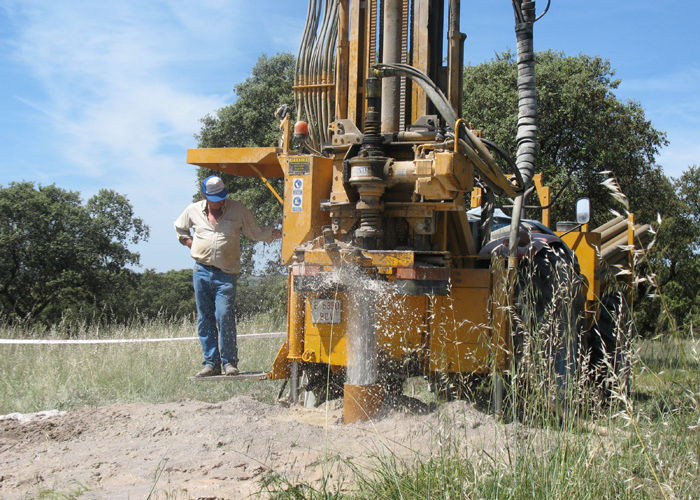
Spain ~ Naval Moral - Drilling on the top of the mountain. Contact with water at 42.5 M - Filling: approx. 15 m3 /h

Australia ~ NSW - Depth: 97 M | Volume: 21m3 /h | Drilling was made only 3 m into the water bearing layer.
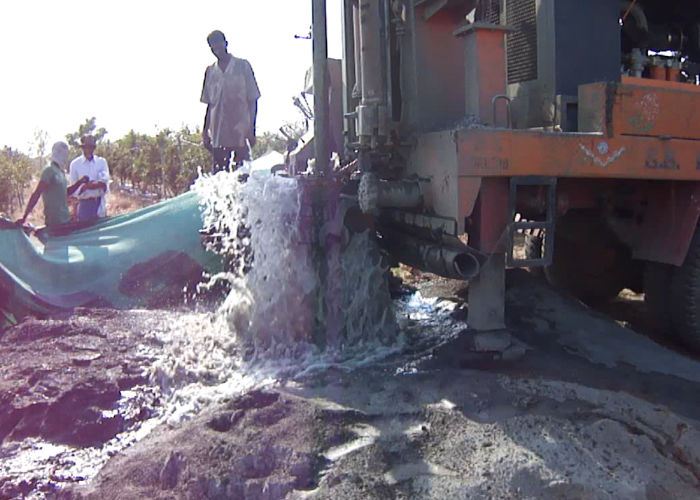
India ~ Madya Pradesh, Indore - Drilling into a vertical core at a depth of 150 M | Contact with water in 150 M | Drilling depth in water only 2 M | Volume: 30 m3 /h

India ~ Uttar Pradesh, Aznar - Drilling in small core, horizontal | Water contact in 32.5 M to 75 M | Volume: 18 m3 /h
Example Of Norbert Cibis' Work:
Special Services: Determination Of Drilling Data:
“Through a long-term environmental medical research project, we have been able to develop methods and procedures with which any water in the earth‘s crust can be located.
Satellite images are sufficient for us to be able to mark the water deposits at depth.
We work according to the “reference principle”.
This means that we do not look for what is reflected from the earth by the vein, but we mark the place where the physical quantities typical of vein water enter the earth‘s surface.
The principle is transferable to all materials.
By working on the screen we have the possibility to examine small and very large areas in one go.
This is the only way we can determine the real sizes and estimate the volume of a vein”.
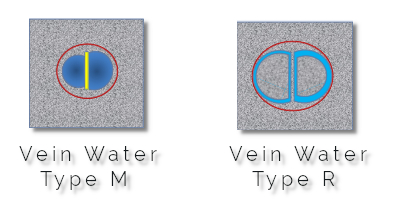
- Vein Water Type M:
- Both water-bearing layers are located close to each other.
- Vein Water Type R:
- Both water-bearing layers are located at the edges.
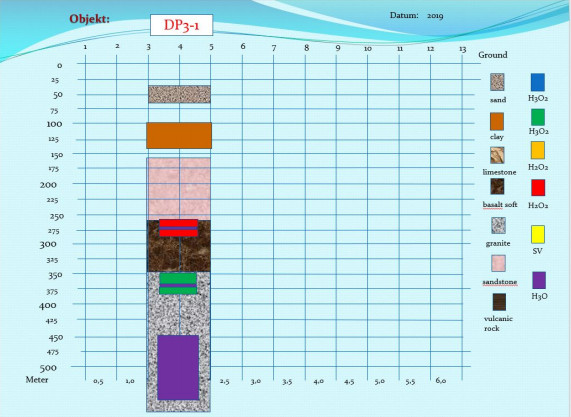
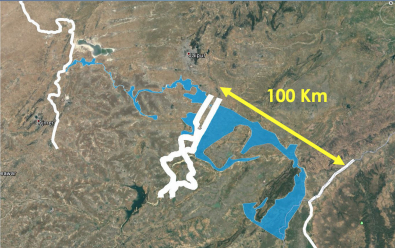
Above Map: The white lines delimit the entire vein of type M Vein Water. The light blue areas show the location of the water areas, in which case the water layers start at 2000 m and go down to 7000 m.
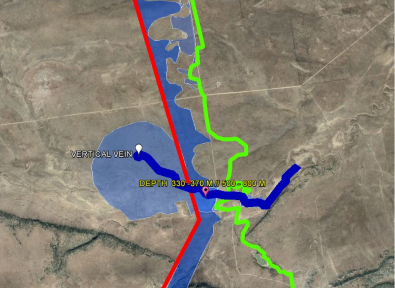
Above Map: The blue lines and areas indicate Vein Water. The North-South running middle blue stripe belongs to type R Vein Water. The round light-blue area has a diameter of 15 km ~ it belongs to the dark blue vein. Red and green lines belong to the boundary of the vein system
Chart On The Left:
This chart shows an example of the types of terrain layering and water layering that may be found in a designated borehole.
The areas with red, green and violet mark the starting and final depth of different water veins that the borehole would pass through.
The Theory Of Vein Water
Vein Water Is Not The Same As Primary Water
It is theorized that Primary Water is probably formed in layers of the earth’s crust about 500 km deep. It then penetrates under pressure through crevices, fissures and cavities to the surface.
Primary Water wells can be very productive. A discharge of about 8000 liters per minute. is not rare. The properties of Primary Water generally correspond to those of groundwater.
Independent researcher Norbert Cibis, however, states that Vein Water is not the same thing as Primary Water, even though both are produced entirely as a result of processes combining Hydrogen and Oxygen which take place deep in the Earth itself.
Vein Water Is Hydrogen Water
According to the pioneering research of Norbert Cibis, (see below) both Primary Water and Vein Water are ‘grown’ or ‘manufactured’ by internal geophysical processes.
However, he theorizes that the key difference between the two being that Vein Water is produced from oxygen in the Earth apparently combining with Hydrogen from Space that is constantly being incorporated by and within the Earth.
This natural process, which takes place under immense pressure in the Earth’s mantle, allegedly then creates a distinct hydrogen-rich molecular structure for Vein Water, which some people refer to as, ‘Hydrogen Water’ or “Hexagonal Water”.
The picture on the right (provided by Norbert Cibis) allegedly shows the two water types flowing directly next to each other.
Norbert Cibis States:
“The white stream shown in the image on the right contains PRIMARY WATER and groundwater, plus many suspended particles, hence the white coloration.
The black river on the right, in the image, contains pure VEIN WATER, which is more dense than PRIMARY WATER, as a result, this water type (VEIN WATER) does not mix with normal water.
The name VEIN WATER comes from the fact that this water flows in so-called veins, as with humans. This circumstance in turn is a prerequisite for the special quality of the water. It is a self-contained system.”
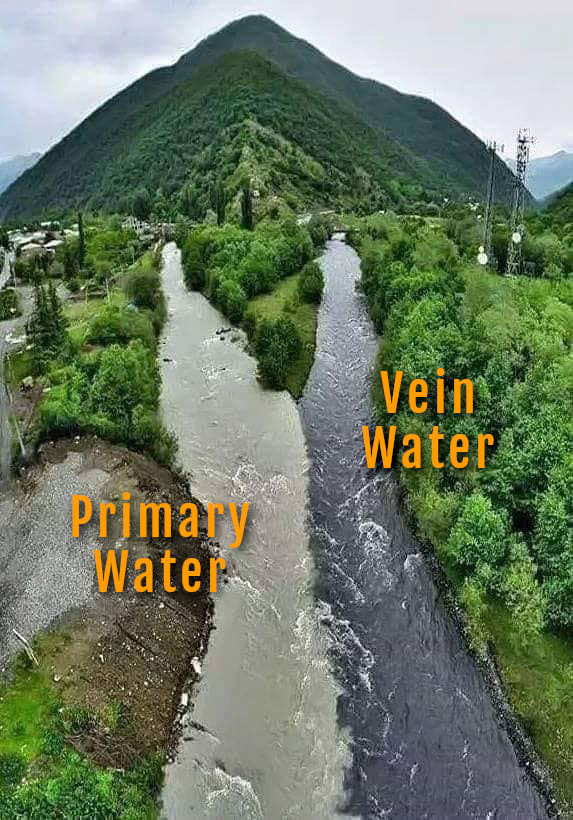
The Special Nature Of Vein Water
Norbert Cibis
Further Maintains That:
Norbert Cibis further maintains that:
“There are a number of different molecular-lattice-structures found within Vein Water, as a result of which Vein Water has a higher density than Primary Water or ‘ordinary’ water. The picture on the right illustrates what a molecular section of Vein Water could look like. “
“Because such lattices trap UV light and have a high density, germs cannot penetrate these water structures in Vein Water. It therefore always remains germ-free.”
“In addition to the above, it should be noted that there is a strong electric charge generated by released hydrogen. In living organisms, this has an antioxidant effect”.
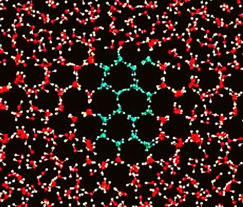
(The following statement is based on the paradigm shifting research of Dr. Gerald Pollack: https://www.pollacklab.org/)
“Individual water-molecules can form lattice systems, also called clusters, by wall contact. If such clusters lie on top of each other in several layers, they behave similarly to crystals.”
Norbert Cibis Continues:
“Furthermore, storing water is a big problem in hot climates.
Normally it is no longer potable after one day.
Vein water has been stored for over 10 years and it was still drinkable then.
A laboratory test, showed that the germination behavior of microbes in vein water (red) and normal tap water (green) during a period of 10 days.”
(Illustrated in the graph on the right)
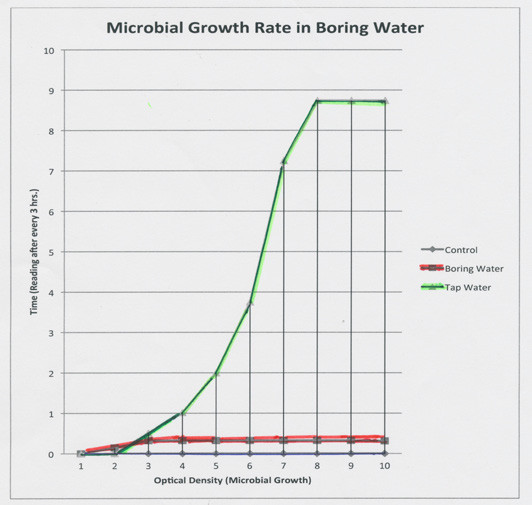

Collaborating To Bring Authentic Solutions
For A Better World
The following innovators have agreed to collaborate with us to bring water renewal solutions to The Navajo Nation:

Lyn Hebenstreit

Norbert Cibis
Remembering Pal Pauer
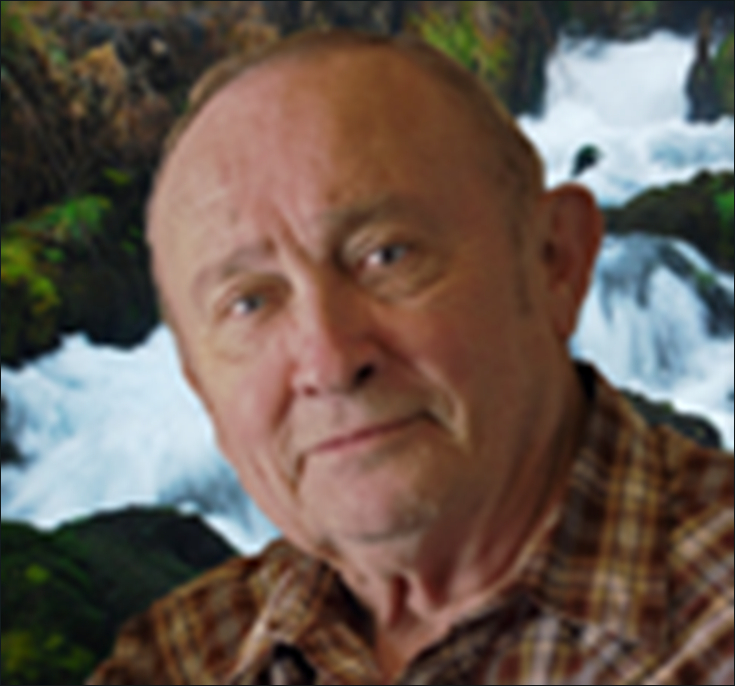
Pal Pauer ~ 1931 – 2022
Hydro-geologist Pal Pauer dedicated his life to the betterment of humanity, selflessly helping those in need of water.
Many were poor, living in drought ridden areas. Pal left us his legacy of research, knowledge and experience to help save our planet from water shortage. In high regard.
Thank you Pal